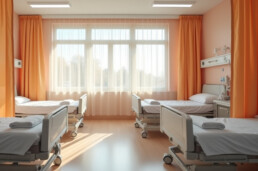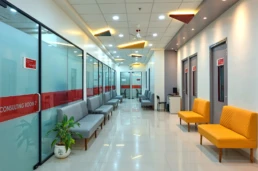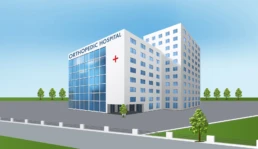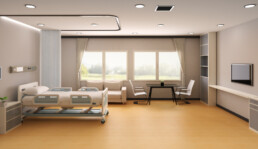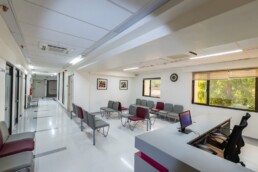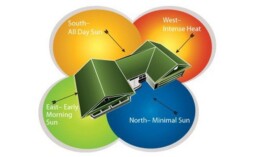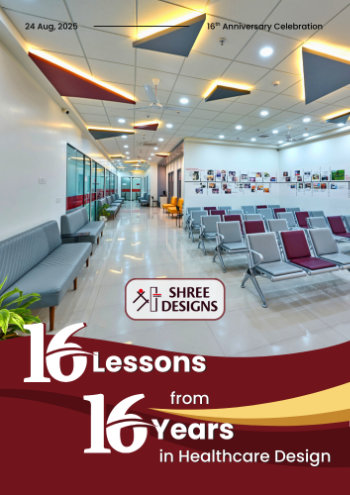Designing NABH-Compliant Hospital Interiors: A Deep Dive into Safety, Efficiency, and Patient Care
When designing a hospital, every detail matters—not just for aesthetics but for compliance, patient safety, and operational efficiency. In India, the National Accreditation Board for Hospitals & Healthcare Providers (NABH) sets the benchmark for hospital quality, covering everything from infrastructure and infection control to emergency preparedness.
For healthcare architects and designers, aligning with NABH is not another item to check off a list. Instead, it helps in designing environments that enable better care.
Let’s break down the critical aspects of NABH-compliant hospital interiors, using real-world scenarios to understand how design choices can impact patient safety, workflow efficiency, and long-term operational success.
1. Facility Management and Safety (FMS): Designing for Resilience and Emergency Preparedness
The Challenge: A fire breaks out in the ICU due to a short circuit in the oxygen supply unit. Staff struggle to locate fire extinguishers, and patients need immediate evacuation.
How NABH-Compliant Design Prevents This:
- Fire Safety Infrastructure: NABH mandates fire detection and suppression systems such as automatic sprinklers, smoke detectors, and fire-retardant building materials. Example: In high-risk areas like ICUs and operating rooms, walls should have a minimum fire resistance of two hours to contain the spread.
Fire safety is a crucial component of NABH compliance, ensuring hospitals are prepared for emergencies. To understand the best materials and techniques for fireproofing your healthcare facility, check out our detailed guide on Fireproofing in Healthcare Design
- Evacuation Planning: Hospital corridors must be at least 2.4 meters wide, ensuring that stretchers and wheelchairs can move without obstruction. Emergency exits should be clearly marked with glow-in-the-dark signage for easy identification during power outages.
- Structural Integrity: In earthquake-prone areas, hospitals should follow seismic-resistant design standards (IS 1893). This includes flexible joints in pipelines and reinforced wall structures to prevent structural collapse during tremors.
2. Hospital Infection Control (HIC): Designing for a Germ-Free Environment
The Challenge: A post-surgical patient in the general ward develops a severe secondary infection suspected to have spread from another patient in the same room.
How NABH-Compliant Design Prevents This:
- Dedicated Isolation Rooms: Critical care and infectious disease wards must have negative pressure ventilation to contain airborne pathogens. Example: A tuberculosis patient should never share air circulation with the general ward.
- Antimicrobial Finishes: Wall claddings, flooring, and door handles should be coated with microbial-resistant materials such as copper-infused metals or silver-ion-treated plastics. Flooring should be coved at junctions to prevent dust and microbial buildup.
- HVAC & Air Filtration: NABH mandates separate air handling units (AHUs) for different hospital zones. Example: Operating theatres should have HEPA filters and laminar airflow systems to maintain sterile air quality below 100 CFU/m³.
3. Patient Rights and Education (PRE): Enhancing Comfort, Accessibility, and Privacy
The Challenge: A visually impaired patient struggles to find their way to the outpatient department, leading to delays in treatment.
How NABH-Compliant Design Prevents This:
- Universal Accessibility: Hospitals must be designed for barrier-free access. This includes:
- Tactile paving for visually impaired patients
- Low-height counters at reception for wheelchair users
- Voice-assisted elevators
- Noise Reduction & Privacy: In multi-bed wards, NABH mandates at least 1.2 meters of space between patient beds to prevent cross-infection and ensure privacy. Sound-absorbing ceiling tiles reduce ambient noise, which is linked to lower stress levels and better patient recovery.
- Clear Signage: Multilingual and pictogram-based signage helps both literate and illiterate patients navigate the hospital independently.
“Well-planned hospital layouts minimize confusion, reduce patient stress, and improve staff efficiency. Learn how to optimize wayfinding and hospital navigation with our insights on Navigational Design in Hospitals.”
4. Patient Safety and Quality Improvement (PSQ): Creating a Safe Healing Environment
The Challenge: A patient receiving chemotherapy falls in the bathroom due to slippery tiles and poor lighting.
How NABH-Compliant Design Prevents This:
- Slip-Resistant Flooring: Bathrooms should have non-slip vinyl flooring (R11 slip rating) and grab bars for support.
- Lighting & Visibility: NABH recommends 300 lux brightness in patient areas and 500 lux in treatment zones. Example: In ICU units, motion-sensor night lights help nurses check on patients without disrupting sleep.
- Patient Identification and Monitoring: RFID-enabled patient wristbands prevent medication errors by ensuring automated identity verification before treatment.
Creating an accessible and patient-friendly environment isn’t just about compliance—it improves safety and efficiency for both patients and healthcare staff. Explore our in-depth analysis on Ergonomics in Healthcare Design to implement the best practices.
5. Responsibilities of Management (ROM): Ensuring Long-Term Compliance & Performance
The Challenge: A newly built hospital receives complaints about long patient wait times due to poorly designed consultation rooms and unclear wayfinding.
How NABH-Compliant Design Prevents This:
- Departmental Zoning for Efficiency: NABH guidelines emphasise logical zoning to separate high-risk areas (OT, ICU) from OPD and administration. Example: Locating radiology near an emergency ensures faster scans for critical patients.
- Waiting Area Optimization: Hospitals must have separate waiting zones for high-risk, paediatric, and general patients to prevent disease transmission.
- Regular Design Audits: NABH mandates annual audits of hospital infrastructure to identify safety gaps and improve workflows.
Final Thoughts: Why NABH-Guided Hospital Design Matters
NABH accreditation isn’t just about ticking boxes—it’s about designing hospitals that save lives.
By integrating NABH principles from the blueprint stage, architects and healthcare designers can:
✅ Reduce medical errors through better workflow planning
✅ Prevent hospital-acquired infections (HAIs) with advanced materials & air systems
✅ Improve patient experience through accessibility & comfort-focused interiors
✅ Enhance emergency preparedness through strategic zoning & fire safety
When NABH standards back healthcare design, hospitals function smarter, safer, and more efficiently.
For the latest NABH hospital design regulations, visit NABH official website
Need expert advice on designing NABH-compliant hospitals?
Let’s build safer healthcare spaces together.
Related Posts
Designing Healthcare Facilities
The Science of Hospital Windows
Windows in hospitals do far more than bring in light; they influence recovery rates, infection…
Infographic,Designing Healthcare Facilities
How Design Impacts Patient Care
Ever wondered what goes into designing a hospital or clinic that truly works - for doctors, staff,…
Designing Healthcare Facilities
Textures in Healthcare Spaces
When designing hospitals or clinics, texture is often seen as a “finishing touch.” At Shree…
Designing Healthcare Facilities,Infographic
The Lifecycle of a Healthcare Facility Design
Ever wondered what goes into designing a hospital or clinic that actually works - clinically,…
Designing Healthcare Facilities,Infographic
Blueprint for Healthcare Design
From room dimensions to lighting levels, every detail matters in healthcare design. At Shree…
Designing Healthcare Facilities
Building Better Day Surgery Centres
Efficient care, happier patients, and smarter workflows - this is what defines a successful…
Designing Healthcare Facilities,Infographic,Project Management
Designing Healthcare Spaces That Truly Heal
From concept to completion, every medical space we design prioritizes patient flow, staff…
Designing Healthcare Facilities
The Business of Wellness
In the $1.8 trillion wellness industry, first impressions matter. Patients don’t just choose a…
Designing Healthcare Facilities
Efficient Hospital and Clinic Design
India’s emerging cities are growing rapidly, creating an urgent demand for accessible and efficient…
Designing Healthcare Facilities
Creating Calming and Confidential Spaces for Fertility Clinics
As the demand for fertility treatments grows, the architecture of these clinics plays a vital role…
Designing Healthcare Facilities
Designing the Perfect Hospital Pharmacy
Hospital pharmacies are the backbone of seamless patient care. From efficient workflows to secure…
Designing Healthcare Facilities
Preventive Care Facility Design Strategies
With preventive care emerging as the future of healthcare, this post outlines key architectural…
Designing Healthcare Facilities
Thermal Comfort Decoded
Thermal comfort plays a critical role in patient recovery, staff productivity, and overall…
Designing Healthcare Facilities
Building for Tomorrow: The Imperative of Adaptable Healthcare Design
Healthcare facilities need to be as dynamic as the industry itself. Traditional, rigid designs can…
Designing Healthcare Facilities
Designing Single Speciality Healthcare Centres
As single-speciality centres grow, their design needs become more specific, calling for tailored…
Designing Healthcare Facilities
Innovative Design Solutions for Senior Care Facilities
Designing senior-friendly spaces in healthcare facilities is crucial for catering to the evolving…
Designing Healthcare Facilities
Designing a Dental Clinic for Success
Providing quality dental care is not just about the technical elements of the treatment. It's also…
Designing Healthcare Facilities
3 Essential Design Features for Intensive Care Units
ICUs are not just limited to single units housing all critical patients. If the facility has…
Designing Healthcare Facilities
3 Lessons Learned While Building a Cardiac Cath Lab
Cardiac care design is moving at the sound of a new beat! The number of Cath labs in India has…
Designing Healthcare Facilities
5 Essential Elements of Healthcare Design
Design makes a significant impact on the delivery of care for both healthcare providers and…
Designing Healthcare Facilities
5 Best Ways to Create Healing Spaces for Kids
Designing spaces in healthcare facilities tailor-made for children is a lesson in balance! A…
Designing Healthcare Facilities
Top 5 Trends in Healthcare Design
Design can make all the difference when it comes to improving patient care. From a patient’s point…
Designing Healthcare Facilities
The Architectural Design of Hospital Facilities
Shree Designs designed and executed many efficient and safe healthcare setups in the middle of the…
Designing Healthcare Facilities
Dauntless Designers
Healthcare Radius in its 7th Anniversary Special issue in October 2019, featured a "power list of…
Designing Healthcare Facilities
The changing face of healthcare design
After completing a decade in designing healthcare projects, Kshititi Nagarkar, principal architect,…
Designing Healthcare Facilities
Thumb Rules for Planning and Designing of Hospitals
Traditional rules of thumb in healthcare planning have changed. Once-accepted rules can now be the…
